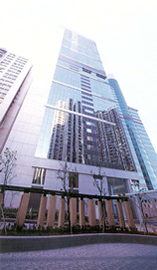| Notable Features |
| |
 |
Application of
system formwork |
 |
Use of
prefabricated door sets |
 |
Distributed
separation of
waste |
 |
Reuse of steel formwork |
 |
Use of
sub-tropical timber |
 |
Reuse of steel
hoarding |

| Basic
Information |
| |
 |
Location: Quarry
Bay |
 |
Building Type: Residential |
 |
Contract Period:
17/3/1997 – 11/8/1999 |
 |
Gross
Floor Area: 62,000m2 |
 |
Client:
Cathay Limited (Swire Properties Ltd.) |
 |
Architect: Wong
& Ouyang (HK) Ltd. |
 |
Structural Engineer:
: Mouchel Asia Limited |
 |
E&M
Consultant: Meinhardt (M&E) Ltd. |
 |
Quantity Surveyor: Levett
& Bailey |
 |
Main Contractor: Gammon
Construction Ltd. |
 |
Contract Sum: HK$
800 million |

| Overview |
| |
| The project involved the construction of a
40-storey office building with a 2-level podium, four-level top-down basement and a linkbridge to Somerset House. The gross floor area
is approximately 63,000 square metres. The 660-day construction period was extended due to
the addition of an extra floor. |
|
|
|

|
| System Formwork |
| |
| Steel
formwork was used to construct the column and structural wall
of the building. The floor slab was relatively large in span
and table form was used for its less time for assembly,
reduction in the number of joints and better surface finishes.
Post tensioning beams were used to reduce the depth of the
beam, thus achieving a higher headroom. The external facade
was curtain wall. |
| |
| The
steel forms had already been used for three sites. The set of
formwork was modified and reused for this site and then
scrapped for recycling.
|
| |
| A
6-day concreting cycle was adopted. It was considered the same
speed as the traditional method. The table form had a cost
advantage as compared to the traditional method. It was
estimated there was a cost saving of HK$ one million.
|
| |
|

|
|
|
|
![]() |
|
| Waste Management |
| |
 |
On-site
sorting of waste |
|
|
| No
sorting of waste was performed during concreting stage due to
lack of space. Distributed separation was adopted during the
finishing stage. The waste was separated at the respective
floors and then transported to the ground floor for disposal.
Large timber panel, steel, packaging materials were sorted out
and then transported by the tower crane or hoist. However,
paper, lunch boxes and cans were not sorted out and were mixed
with rubble which was transported through refuse chute to the
ground floor. An area of 1000 square feet was allowed for
storage of different piles of waste. The problems associated
with waste reduction were the extra resource and time
required. It was considered that centralised separation was
not feasible because it was difficult to sort out the waste
when they were mixed together and more space was required
to carry out the sorting. |
|
|
 |
Material
Control |
|
| There
were appropriate procedures in accordance with ISO 9000 and
short term programming for the material ordering, inspection,
storage, distribution and checking of quantities of materials,
including those supplied to sub-contractors.
|
|
|
 |
Use
of recycled materials |
|
|
|
|

|
The
steel formwork had been used for another site already. It
would be reused or scrapped and transported to China for
resale depending on the condition of the material. |
|
|
 |
Reusable
materials
|
|
|
|
|

|
steel hoarding |
|

|
steel formwork |
|
| |
|

|
| Prefabricated
Doorsets |
| |
| Prefabricated
door frames and doors were used in this project. These doorsets
saved the temporary timber support for door frame, thus reducing
waste. |
| |
|

|
| Contact
of Contractor
|
| |
| Gammon
Construction Ltd. |
| 28th Floor, Devon House |
| TaiKoo Place, 979 King's Road |
| Hong Kong |
| Tel:
(852) 2516 8823
|
| Fax:
(852) 2516 6260
|
|
|
|

|
|
